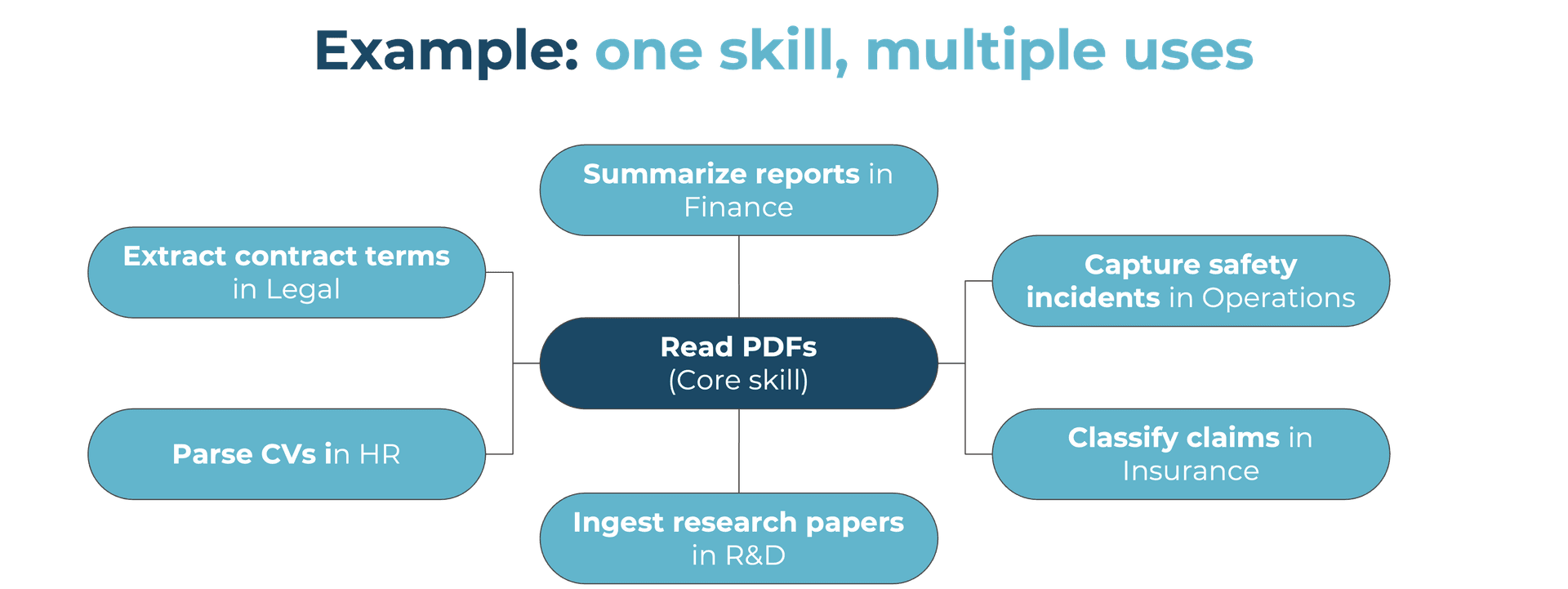
Reusable intelligence: building enterprise capabilities that teach themselves
Agentic AI shifts business logic from rebuilding capabilities to capturing and reusing them, creating reusable intelligence that compounds over time.
Reusable intelligence: building enterprise capabilities that teach themselves
Every enterprise has a secret hobby: rebuilding what it already owns. New strategy, new tools, new project names, but the same underlying capability, reinvented for the third time in five years. Every team creates its own version of "innovation," and then starts again from zero the next quarter.
Agentic AI changes that logic. It doesn't just automate tasks, it captures how work gets done and teaches others to do it. Each "digital colleague" learns a capability once, then shares it a hundred times. One of our clients said, "We realized our people were solving the same problem five times in different departments, the agents solved it once and shared the playbook."

“ The next competitive advantage isn't speed, it's reuse. Every digital colleague you deploy learns a skill that should never stay local. The real power is when those skills travel, when one agent's pattern becomes another's capability. That's how enterprises start compounding intelligence instead of just scaling headcount. ”
That's when innovation stops being a department and starts being a network.
Context and setup: why skills don't scale the way they should
Traditional enterprises are good at projects but bad at memory. Every initiative builds isolated expertise; a new team, a new tool, a new acronym. Then the expertise quietly fades when the budget resets. Most organizations still treat skills like possessions, not platforms. They train, document, and lock them in silos instead of letting them flow.
Here's how that looks in practice:
- Expertise trapped in teams and tools.
- Skills that expire faster than they spread.
- Innovation that resets with every project.
- No shared memory across the enterprise.
The irony? Most companies don't lack talent, they lack knowledge transfer. Agentic AI flips this logic. It turns capability into code; reusable, composable, and self-improving. When an agent learns how to reconcile invoices or detect anomalies, that know-how becomes portable. You can drop it into the next process like an API. As one client put it, "Once we saw an agent reuse a skill from finance in operations, we realized we weren't automating, we were compounding."
From talent to transferable intelligence
In the old model, you hired expertise. In the agentic model, you capture it. Agents don't just perform work, they remember, adapt, and transfer what they learn. Each deployment leaves behind a skill asset that others can reuse. That's how enterprises move from manual reinvention to reusable intelligence.
- Capture expertise as prompts, patterns, and decision logic that agents reuse.
- Convert tribal knowledge into machine-readable skill libraries.
- Use agentic frameworks so every new agent inherits what others learned.
- Create "capability APIs"; modular skillsets that plug into new domains.
One client said, "Our second agent deployed in half the time, because the first one had already written the manual." When capability compounds, innovation stops being a workshop; it becomes the operating system.

Building the capability network
Most companies talk about centers of excellence. The future is circulation of excellence. Every AI deployment leaves behind connectors, policies, and datasets that can accelerate the next. Instead of scaling people, you scale what they've taught your digital colleague.
Think of it as a living capability network; part data, part process, part learned behavior.
- Map reusable components across projects, from prompts to models to guardrails.
- Reward reuse and remix, not reinvention.
- Build light bridges, access, context, permissions, so agents can cross domains.
- Treat every AI project as both a solution and a seed.
Another client said, "Once we stopped optimizing and started sharing, everything accelerated." That's the compounding effect: every capability becomes a foundation for the next, and value spreads faster than governance can keep up.
Human skills that compound with AI
Reusable capability isn't just about machines. It's about humans learning differently. As agents handle the routine, people gain visibility into how skills evolve — they can see the patterns, shortcuts, and exceptions encoded into the system.
The new skill isn't just knowing how to do the work, it's knowing how the work learns.
- Free experts to focus on sense-making and experimentation.
- Let digital colleagues expose how best practice actually forms.
- Reframe training from skill acquisition to skill orchestration.
- Encourage "learning in the flow" — between people and agents, in real time.
When humans and agents share learning loops, the enterprise becomes self-updating. The skill curve bends upward every day, not every fiscal year.
What enterprises should do now
Stop hoarding expertise, start compounding it. Reusable capabilities are the new compounding interest of enterprise performance.
Here's how to begin:
- Start by mapping one skill that repeats across functions, automate and share it.
- Build a lightweight capability library that every new agent can access.
- Measure reuse: count shared prompts, connectors, and policies inherited across agents.
As one client said, "Once the agents started teaching each other, we realized innovation wasn't a pipeline, it was a network."